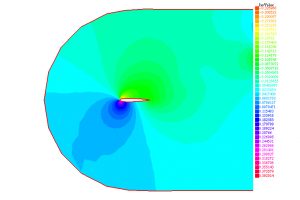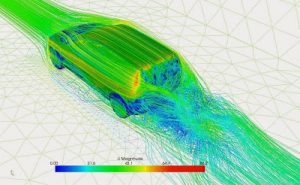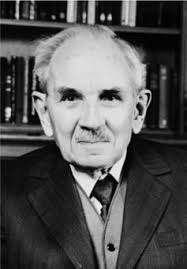This entry refers to one of the seven Millennium Problems, formulated in the year 2000, whose solution is rewarded with one million dollars: analysis of the existence of a “classical” solution of the Navier-Stokes equations.

The equations:
The purpose behind this is to describe the behaviour of a Newtonian fluid. To do so, we must accept that the fluid is made up of advancing particles transported by a velocity field, “pushing” or pressing and rubbing each other. In the simplest version, it is assumed that the mass density is constant (say \(\rho_0\)) and the mechanical state of the fluid is determined at every point \(\mathbf{x} = (x_1,x_2,x_3) \in \mathbf{R}^3\) and at every instant of time \(t \geq 0\) by the values of the velocity field \(\mathbf{u} = \mathbf{u}(\mathbf{x},t)\) (with components \(u_1\), \(u_2\) and \(u_3\)) and pressure \(p = p(\mathbf{x},t)\).
These functions have to verify the partial differential equations (deduced by Navier and Stokes)
$$
\left\{
\begin{array}{l} \displaystyle
\rho_0 \left( \partial_t u_i + \sum_{j=1}^3 u_j \partial_j u_i \right)
– \mu \sum_{j=1}^3 \partial_j^2 u_i + \partial_i p = \rho_0 f_i, \quad i=1,2,3,
\\ \displaystyle
\sum_{j=1}^3 \partial_j u_j = 0 .
\end{array}
\right.
$$
In short, we write
$$
\rho_0 \left( \mathbf{u}_t + (\mathbf{u} \cdot \nabla)\mathbf{u} \right) – \mu \Delta\mathbf{u} + \nabla p = \rho_0 \mathbf{f},
\quad \nabla \cdot \mathbf{u} = 0 .
$$
The equations must be completed with initial conditions and “conditions at infinity” for \(\mathbf{u}\):
$$
\mathbf{u}|_{t=0} = \mathbf{u}_0, \quad \mathbf{u} \to 0 \ \hbox{ as } |\mathbf{x}| \to +\infty.
$$
Here, \(\mu > 0\) is the dynamic viscosity and \(\mathbf{f} = \mathbf{f}(\mathbf{x},t)\) and \(\mathbf{u}_0 = \mathbf{u}_0(\mathbf{x})\) are given functions, respectively interpreted as an external force and an initial velocity field.

The equations tell us that (1) along their trajectories, the acceleration undergone by the particles is proportional to the resultant of the forces acting on them (according to Newton’s famous law) and (2) the volume occupied by a set of particles does not change with time.
It is more realistic to implement the equations in a cylinder \(\Omega \times \mathbf{R}_+\), where \(\Omega \subset \mathbf{R}^3\) is a connected open set. For instance, \(\Omega\) can represent the inside of a pipe, the outside of an obstacle, a riverbed, etc. In these cases, the preceding “at infinity” condition must logically be replaced by some additional information for \(\mathbf{u}\) over \(\partial\Omega \times \mathbf{R}_+\) (i.e. a boundary condition). However, many authors prefer to work on \(\mathbf{R}^3 \times \mathbf{R}_+\); in this way, the techniques of Harmonic Analysis and in particular Fourier Transform have a place and can be expected to help to understand the situation.

The history of these equations is long. We have some important precedents:
-
In ancient civilizations, the interest in understanding the behavior of fluids was associated, among other things, with navigation or the development of irrigation techniques. Archimedes (285-212 B.C.) formulated the principle that bears his name and applied it to flotation problems.
-
In the Renaissance, Leonardo da Vinci (1452-1519) formulated the law of conservation of mass for one-dimensional stationary fluids. He also carried out several ingenious experiments that confirmed this law.
-
In the 17th century, the first wind tunnel was designed, built and used to good advantage by E. Mariotte (1620-1684).
In the deduction of the equations, the initial steps were due to I. Newton (1642-1727), the first to postulate that the particles of a real fluid interact with frictional forces that are proportional to the spatial variations of the velocities. For this reason, we speak of Newtonian fluids; in the system indicated above, the term that accounts for the frictional forces is \(– \mu \Delta\mathbf{u}\).
We next find the contribution of L. Euler (1707-1783), the first to use partial differential equations as a tool to describe the behaviour of a fluid. However, Euler considered ideal fluids, that is, he eliminated in his analysis the friction forces. In other words, he took \(\mu = 0\), thus getting the equations that bear his name.

The complete and definitive formulation came after the independent contributions of C.H. Navier (1785-1836) and G. Stokes (1819-1903), who added the viscous term to Euler’s equations.
Many natural and industrial phenomena can be understood and even described by the solutions of this system: in Aeronautics, they determine the behavior of the air around and behind an object; obviously, they also play a fundamental role in the nautical context; in Meteorology, \(\mathbf{u}\) and specially \(p\) can be crucial in preventing storms and anticyclones; the development and benefits of many industrial processes depend largely on the values of the unknowns over a period of time, etc.
The million dollars:
The Clay Mathematics Institute (https://www.claymath.org) is a non-profit foundation based in Cambridge (Massachusetts, USA) whose main objective is to promote mathematical knowledge. It was founded in 1998 by Landon T. Clay (1926-2017) and Arthur Jaffe (b. 1937), mathematicians from Harvard University.

Landon Clay was not a mathematician. It cannot even be said that he cultivated a taste for solving simple mathematical problems. However, he always appreciated the beauty and importance of mathematical ideas and was aware of the role they can play in the development of mankind. For his part, Jaffe is best known for having founded, together with James Glimm, the so-called constructive theory of quantum fields. In this area, his best achievement was to prove the existence of relativistic quantum fields in dimensions 2 and 3.
The Clay Mathematics Institute hosts a large number of activities. It is particularly known for having proposed in the year 2000 a famous list of seven problems, known as the “Millennium Problems”. It is assumed and expected that these problems will mark a good part of the mathematical activity in the present and immediate future.
One of the Millennium Problems, stated by Ch. Fefferman in [1], is to prove one of the following two statements: (a) with \(\mathbf{f} = 0\), given \(\mathbf{u}_0\) of class \(C^\infty\), smooth and divergence-free, there exists a solution \((\mathbf{u},p)\) to the Navier-Stokes problem, also of class \(C^\infty\), defined for all \(\mathbf{x} \in \mathbf{R}^3\) and all \(t > 0\); (b) there exist \(\mathbf{f}\) and \(\mathbf{u}_0\) of class \(C^\infty\) (\(\mathbf{u}_0\) must be divergence-free and compactly supported) such that the system has no solution of class \(C^\infty\) defined for all \(t > 0\).

Here are some partial answers:
\(\bullet\) When \(\mathbf{f} = 0\) and \(\mathbf{u}_0\) is sufficiently small (in an appropriate sense), question (a) has a positive answer; see [2].
\(\bullet\) When considering two-dimensional fluids (i.e. with all data and variables for example independent of \(x_3\)), it is also possible to answer affirmatively to question (a).
\(\bullet\) In general conditions, it is possible to demonstrate the existence of a “weak” solution, also called a “Leray solution”, defined for every \(\mathbf{x} \in \mathbf{R}^3\) and every \(t > 0\), which is \(C^\infty\) for “small” values of \(t\), i.e. for \(0 < t < T_*\), with \(T_*\) depending on the sizes of \(\mathbf{u}_0\) and \(\mu/\rho_0\); see [2,3]. Put in rather vague terms, a weak solution to the Navier-Stokes equations is a pair \((\mathbf{u},p)\) such that, when multiplying the terms on the left and right sides by arbitrary functions, expressions are obtained whose averages in \(\mathbf{x}\) and \(t\) coincide. It is not known if there are weak solutions that lose regularity in finite time.
\(\bullet\) It is also possible to demonstrate the existence of suitable weak solutions, characterized by satisfying local energy inequalities, see [4, 5]. These solutions are regular, i.e. of class \(C^\infty\), except at a small set of points \((\mathbf{x},t)\) (specifically, a set of zero one-dimensional Hausdorff measure).

\(\bullet\) On the contrary, there are “very similar” but different equations
$$
\rho_0 (\mathbf{u}_t + B(\mathbf{u},\nabla\mathbf{u})) – \mu \Delta\mathbf{u} + \nabla p = \rho_0 \mathbf{f},
\quad \nabla \cdot \mathbf{u} = 0,
$$
where (as above) \(B(\cdot\,,\cdot)\) is bilinear, for which (b) has a positive answer; see [6]. This somewhat surprising result gives an idea of the difficulty of the problem.
In the second part of this entry, we will speak of the various strategies and techniques that have been applied recently with the intention of getting closer to the resolution of the problem. We will also speak in depth of the applied aspects that motivate and allow for interpretations of the desired results.
Learn more:
The full formulation of the Millennium Problem under discussion appears in
[1] Ch. Fefferman, https://www.claymath.org/sites/default/files/navierstokes.pdf.
A classic result showing that, when the initial data are small, the Navier-Stokes problem has a unique solution, is the famous Fujita-Kato Theorem. It has been frequently revisited and was originally formulated in
[2] H. Fujita, T. Kato, On the Navier-Stokes initial value problem. I, Arch. Rational Mech. Anal. 16 (1964), 269-315.
The first theoretical results and, in particular, the definition and properties of the weak solution are due to J. Leray. Not much more is known since his paper was published (in fact, Leray mistakenly used the term “turbulent solution”):
[3] J. Leray, Sur le mouvement d’un liquide visqueux emplissant l’espace, Acta Math. 63 (1934), no. 1, 193-248.
The best results in terms of regularity obtained to date have been achieved in the following papers, where we find the so called admissible weak solutions:
[4] L. Caffarelli, R. Kohn, L. Nirenberg, Partial regularity of suitable weak solutions of the Navier-Stokes equations, Comm. Pure & Appl. Math. 35 (1982), 771-831.
[5] F. H. Lin, A new proof of the Caffarelli-Kohn-Nirenberg theorem, Comm. Pure. & Appl. Math. 51 (1998), 241-257.
Finally, we have the following paper by Tao, who was able to formulate equations very similar in appearance to the Navier-Stokes equations (although with unclear physical meaning), for which the global existence of classical solution is not true in general:
[6] T. Tao, Finite time blowup for an averaged three-dimensional Navier-Stokes equation, J. Amer. Math. Soc. 29 (2016), no. 3, 601-674.

Leave a Reply